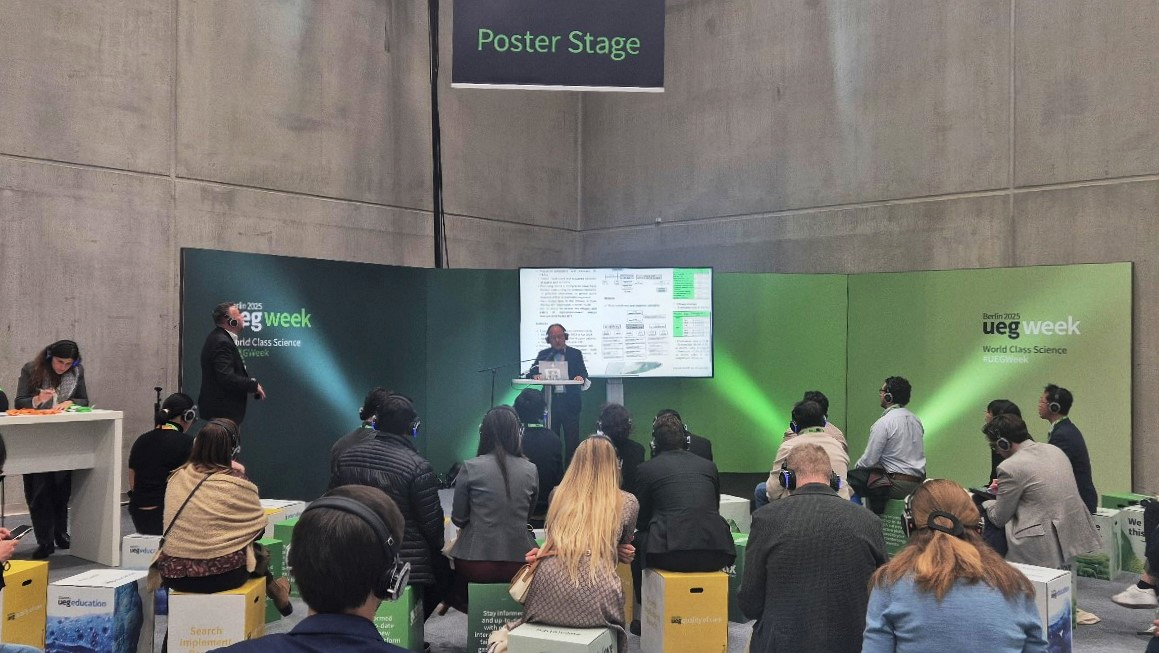HK inno.N Presents Clinical Results of Novel GERD Drug ‘K-CAB’ for H. pylori Eradication at UEGW
HK inno.N
Presents Clinical Results of Novel GERD Drug ‘K-CAB’ for H. pylori Eradication
at UEGW
Comparison
of Dose-Specific Standard Triple Therapy with K-CAB and Lansoprazole for 14-Day
H. pylori Eradication
K-CAB
Achieves Over 80% Eradication Rates Across All Dose Groups, Demonstrating
Superior Therapeutic Efficacy
K-CAB
Highlights Potential as a PPI Replacement for First-Line H. pylori Eradication
Therapy

Photo. The research team presents the clinical results of K-CAB for Helicobacter pylori eradication at the 2025 United European Gastroenterology Week (UEGW).
HK inno.N unveiled the clinical trial results of “K-CAB (active
ingredient: tegoprazan),” its novel drug for gastroesophageal reflux disease
(GERD), demonstrating new possibilities to replace conventional proton pump
inhibitors (PPIs) for Helicobacter pylori eradication. The findings were
presented at the “2025 United European Gastroenterology Week (UEGW),” Europe’s
largest gastroenterology conference, held in Berlin, Germany, from October 4 to
7 (local time).
The clinical trial involved 382 H. pylori-positive patients in Korea
to evaluate the safety and efficacy of standard triple therapy including K-CAB
tablets (tegoprazan), a drug of the P-CAB class, (tegoprazan, amoxicillin, and
clarithromycin), compared to the conventional standard triple therapy with
lansoprazole, a PPI-class drug, (lansoprazole, amoxicillin, and
clarithromycin), administered for 14 days.
The clinical results revealed that the eradication rates in the K-CAB
Tab. 50 mg and 100 mg treatment groups were 85.95% and 85.48%, respectively,
surpassing the 78.74% eradication rate observed in the lansoprazole 30 mg
treatment group, thereby demonstrating the non-inferiority of K-CAB (mITT
analysis set). Notably, K-CAB achieved eradication rates exceeding 80% across
all dose groups, reinforcing its potential as a first-line treatment for H.
pylori eradication.
Currently, the standard triple therapy for H. pylori eradication
involves a standard dose of a PPI drug combined with 1 g of amoxicillin and 500
mg of clarithromycin, administered twice daily. According to the “Revised
Evidence-Based Guidelines for the Treatment of Helicobacter pylori Infection in
Korea (2020),” an eradication rate of at least 80% is recommended for
first-line treatment.
In addition to the Korean clinical trial results, findings from
global, investigator-initiated clinical trials of K-CAB conducted in Latin
America were also presented at the conference. As Latin America is one of the
key overseas markets for K-CAB, HK inno.N plans to accelerate its market
expansion based on accumulated local data.
“The clinical results underscore K-CAB’s capability to replace
conventional PPI-based drugs as a first-line treatment for Helicobacter pylori
eradication,” an HK inno.N representative commented. “We are committed to
further research to strengthen K-CAB’s position in both domestic and global
markets.”
K-CAB, Korea’s 30th novel drug, has achieved cumulative domestic
prescription sales of KRW 810.1 billion since its launch in March 2019 through
the first half of 2025. With features such as △ rapid action after
administration and △ safety demonstrated even after long-term use for up to six
months, K-CAB has ranked No. 1 in domestic outpatient prescription sales for
peptic ulcer treatment. The drug is approved in Korea for five indications: △
erosive gastroesophageal reflux disease, △ non-erosive gastroesophageal reflux
disease, △ gastric ulcer, △ antibiotic combination therapy to eradicate
Helicobacter pylori in patients with peptic ulcer and/or chronic atrophic
gastritis, and △ maintenance therapy after treatment of erosive
gastroesophageal reflux disease. HK inno.N has entered into agreements for the
export of technology or the finished product with 53 countries and has launched
K-CAB in 18 countries, including South Korea, China, and Latin America, further
expanding its global presence. (The End)
Reference Information
P-CAB (Potassium Competitive Acid Blocker / HK
inno.N K-CAB (Tegoprazan))
P-CAB works by
directly binding to the potassium ions of the proton pump, without requiring
activation by gastric acid. This mechanism prevents the binding of potassium
ions to the proton pump, thereby inhibiting gastric acid secretion.
As a result,
P-CAB can be taken regardless of food intake, delivering rapid and potent
gastric acid suppression from the first day of administration. Additionally,
its long-lasting effects surpass PPIs in controlling nocturnal acid secretion.
PPI (Proton Pump Inhibitor / lansoprazole, etc.)
PPIs
irreversibly inhibit the gastric proton pump (Hydrogen/Potassium Adenosine
Triphosphatase; H+/K+-ATPase), which is responsible for the final step of
gastric acid secretion.
PPIs are
prodrugs that require activation by gastric acid before binding to the proton
pump to inhibit gastric acid secretion. Consequently, they must be taken before
meals, and their maximum effect is typically achieved after 3 to 5 days of
consecutive administration.
UEGW: United
European Gastroenterology Week
Source of the standard triple therapy for
Helicobacter pylori eradication
Revised
Evidence-Based Guidelines for the Treatment of Helicobacter pylori Infection in
Korea (2020) (https://doi.org/10.3904/kjm.2021.96.3.160), published in The
Korean Journal of Internal Medicine: Volume 96, Issue 3 (2021).
Title of the clinical trial in Korea
A Randomized,
Double-Blind, Active-Controlled, Multicenter Study Evaluating the Safety and
Efficacy of Tegoprazan-Based Standard Triple Therapy for Helicobacter pylori
Eradication
Titles of the investigator-initiated clinical
trials in Latin America
- Near-Complete
Eradication of Helicobacter pylori in a Latin American Cohort Using
Limecycline–Tegoprazan-Based Quadruple Therapy: Overcoming Antibiotic
Resistance in Real-World Settings
- Non-Inferiority
Trial Comparing Tegoprazan and Esomeprazole for Helicobacter pylori Eradication
in Treatment-Naive Latin American Patients
K-CAB has been launched in the following 18
markets (out of 54 entered markets including South Korea)
▲South Korea
▲China (Country to which technology has been exported)
▲Mongolia, Philippines, Mexico, Indonesia, Singapore, Peru, Chile,
Colombia, Dominican Republic, Nicaragua, Honduras, Guatemala, El Salvador,
Panama, India, and Malaysia (16 countries to which the finished product has
been exported)